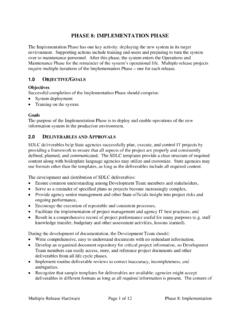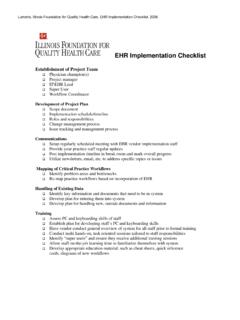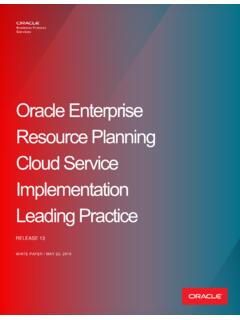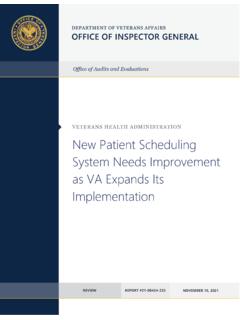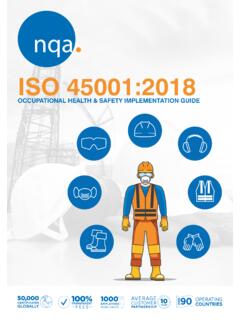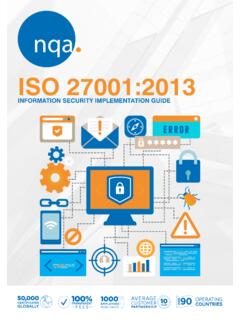Transcription of Section III:6 System Implementation 177
1 Section III:6 System Implementation177 NYS Project Management Guidebook6 System IMPLEMENTATIONP urposeThe purpose of System Implementationcan be summarized asfollows: making the new System available to a prepared set ofusers (the deployment), and positioning on-going support andmaintenance of the System within the Performing Organization(the transition). At a finer level of detail, deploying the systemconsists of executing all steps necessary to educate theConsumers on the use of the new System , placing the newlydeveloped System into production, confirming that all datarequired at the start of operations is available and accurate, andvalidating that business functions that interact with the systemare functioning properly. Transitioning the System supportresponsibilities involves changing from a System developmenttoa System support and maintenancemode of operation, withownership of the new System moving from the Project Team tothe Performing key difference between System Implementation and all otherphases of the lifecycle is that all project activities up to thispoint have been performed in safe, protected, and secure envi-ronments, where project issues that arise have little or noimpact on day-to-day business operations.
2 Once the systemgoes live, however, this is no longer the case. Any miscues atthis point will almost certainly translate into direct operationaland/or financial impacts on the Performing Organization. It isthrough the careful planning, execution, and management ofSystem Implementation activities that the Project Team canminimize the likelihood of these occurrences, and determineappropriate contingency plans in the event of a of Processes This phase consists of the following processes: Prepare for System Implementation , where all stepsneeded in advance of actually deploying the application areperformed, including preparation of both the productionenvironment and the Consumer communities. Deploy System , where the full deployment plan, initiallydeveloped during System Design and evolved throughoutsubsequent lifecycle phases, is executed and validated. Transition to Performing Organization,where responsi-bility for and ownership of the application are transitionedfrom the Project Team to the unit in the PerformingOrganization that will provide System support and following chart illustrates all of the processes and deliver-ables of this phase in the context of the System III:6 System ImplementationNYS Project Management GuidebookSection III.
3 6 System Implementation179 NYS Project Management GuidebookFigure 6-1 Prepare for System AcceptanceValidate Data Initialization and ConversionTest, Identify, Evaluate, React (TIER)Refine SupportingMaterialsPrepare for System ImplementationDeploySystemTransition toPerforming OrganizationSystem AcceptanceSystem ImplementationRevised User/Training MaterialsRevised Technical DocumentationAcceptanceTest ResultsData ValidationResultsFigure 6-2 List of DeliverablesThe following table lists all System Implementation processes,some techniques available for use in executing these processes,and process outcomes and of RolesThe following roles are involved in carrying out the processesof this phase. Detailed descriptions of these roles can be foundin the Introductions to Sections I and III. Project Manager Project Sponsor Business Analyst Data/Process Modeler Technical Lead/Architect Application Developers Software Quality Assurance (SQA) Lead Technical Services (HW/SW, LAN/WAN, TelCom) Information Security Officer (ISO) Technical Support (Help Desk, Documentation, Trainers) Customer Decision-Maker Customer Representative Consumer Performing Organization StakeholdersProcessesTechniquesProcess Deliverables (Outcomes)Prepare for SystemInterviewsEstablished Team andImplementationDistribution of MaterialsEnvironment for Coordination of Training LogisticsSystem Implementation Deploy SystemTraining SessionsMigrated and InitializedManual Business OperationsData Parallel OperationsOperational SystemTransition to Training SessionsOwnership of System byPerformingPhased OwnershipPerforming Organization Organization180 Section III:6 System ImplementationNYS Project Management GuidebookSection III.
4 6 System Implementation181 NYS Project Management FOR System IMPLEMENTATIONP urposeThe purpose of Prepare for System Implementationis totake all possible steps to ensure that the upcoming systemdeployment and transition occurs smoothly, efficiently, the Implementation of any new System , it is nec-essary to ensure that the Consumer community isbest positioned to utilize the System once deploy-ment efforts have been validated. Therefore, allnecessary training activities must be scheduledand coordinated. As this training is often the firstexposure to the System for many individuals, itshould be conducted as professionally and compe-tently as possible. A positive training experience isa great first step towards Customer acceptance ofthe System Implementation it is essential thateveryone involved be absolutely synchronized withthe deployment plan and with each other. Often theperformance of deployment efforts impacts manyof the Performing Organization s normal businessoperations.
5 Examples of these impacts include: Consumers may experience a period of time in which thesystems that they depend on to perform their jobs are temporarily unavailable to them. They may be asked tomaintain detailed manual records or logs of business functions that they perform to be entered into the new System once it is operational. Technical Services personnel may be required to assumesignificant Implementation responsibilities while at thesame time having to continue current levels of service onother critical business systems. Technical Support personnel may experience unusuallyhigh volumes of support requests due to the possible disruption of day-to-day Project Manager Project Sponsor Business Analyst Data/Process Modeler Technical Lead/Architect SQA Lead Technical Services Information Security Officer Technical Support Customer Decision-Maker Customer Representative Consumer Performing Organization Stakeholders182 Section III:6 System ImplementationNYS Project Management GuidebookBecause of these and other impacts, the communication ofplanned deployment activities to all parties involved in the proj-ect is critical.
6 A smooth deployment requires strong leadership,planning, and communications. By this point in the project life-cycle, the team will have spent countless hours devising andrefining the steps to be followed. During this preparationprocess the Project Manager must verify that all conditions thatmust be met prior to initiating deployment activities have beenmet, and that the final green light is on for the team to final process within the System Development Lifecycle is totransition ownership of the System support responsibilities tothe Performing Organization. In order for there to be an effi-cient and effective transition, the Project Manager should makesure that all involved parties are aware of the transition plan,the timing of the various transition activities, and their role inits to the number of project participants in this phase of theSDLC, many of the necessary conditions and activities may bebeyond the direct control of the Project Manager.
7 Consequently,all Project Team members with roles in the implementationefforts must understand the plan, acknowledge their responsi-bilities, recognize the extent to which other implementationefforts are dependent upon them, and confirm their than at any other point in the project, the Project Manager must plan for failure, and must have a defined set of contingency plans to be executed in the event of aproblem encountered during deployment. Stakeholders and all key decision-makers mustclearly understand and agree to the various go/no go criteria by which decisions will be madewhether or not to proceed with the deployment. In the event of a failure, time lost as a resultof an ill-defined course of action can be costly not only in terms of Project Budget, but equal-ly important, in terms of Customer and Consumer III:6 System Implementation183 NYS Project Management SYSTEMP urposeThe purpose of the Deploy Systemprocess is to perform allactivities required to successfully install the new System andmake it available to the the System is the culmination of all prior efforts where all of the meetings, planning sessions, deliverablereviews, prototypes, development, and testing pay off in thedelivery of the final System .
8 It is also the point inthe project that often requires the most coordina-tion, due to the breadth and variety of activitiesthat must be performed. Depending upon the com-plexity of the System being implemented, it mayimpact technical, operational, and cultural aspectsof the organization. A representative sample ofhigh-level activities might include the installationof new hardware, increased network capabilities,deployment and configuration of the new systemsoftware, a training and awareness campaign, acti-vation of new job titles and responsibilities, and acompletely new operational support structureaimed at providing Consumer-oriented assistanceduring the hours that the new System is availablefor use (to name a few). Whatever the realm ofactivities related to the new System , their impactsshould be addressed in the Organizational ChangeManagement Plan, while specific deployment activ-ities should all be encompassed in the ProjectImplementation and Transition Plan, (both created during theProject Planning phase of the Project Management Lifecycle.)
9 Depending upon the environment or the type of System being implemented, this phase may also warrant additional activities including sunsetting (retiring) any relatedlegacy systems, executing parallel runs, and managing external Project Manager Project Sponsor Business Analyst Data/Process Modeler Technical Lead/Architect SQA Lead Technical Services Information Security Officer Technical Support Customer Decision-Maker Customer Representative Consumer Performing Organization StakeholdersAll Consumer training should be performed prior to physicallymigrating the System to the production environment. This willenable the Consumers to begin to familiarize themselves withthe System , and will help to establish their expectations regard-ing what the System will and will not sequencing of deployment activities is just as important asit was with previous testing activities. This sequence of eventsshould be encompassed in the Deployment and Transition Plansection of the Technical Specification, and will address and pri-oritize any necessary training activities, set-up activities need-ed to prepare the production environment (desktop, LAN,servers, data center, etc.)
10 , and data conversion and validationactivities. This deployment plan will also define the steps forphysically migrating the System and any associated utilities toproduction, and for validating the accuracy and completenessof this migration after these steps have been performed. Duringdeployment, Project Team members may often be required towork extra hours to meet aggressive timeframes, or additionalstaff may be brought in temporarily to assist with large dataentry efforts. Proper planning and sequencing of the deploy-ment can help to minimize these situations, and reduce thechance of any missteps that could result in having to restart thedeployment process, or lengthen the Implementation the System is enabled, and the Project Team validates thatthe application is performing to expectations, there may betimes when certain System functions seem suspect. One of thechallenges most frequently faced by Project Teams is to deter-mine the root cause of potential issues.










